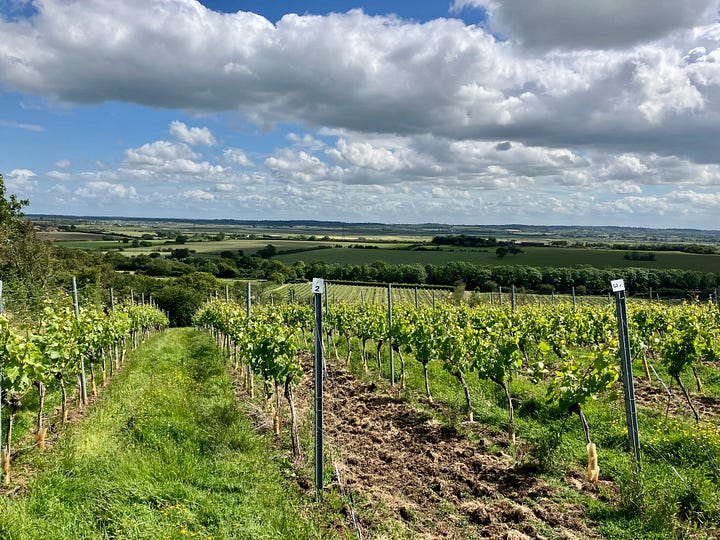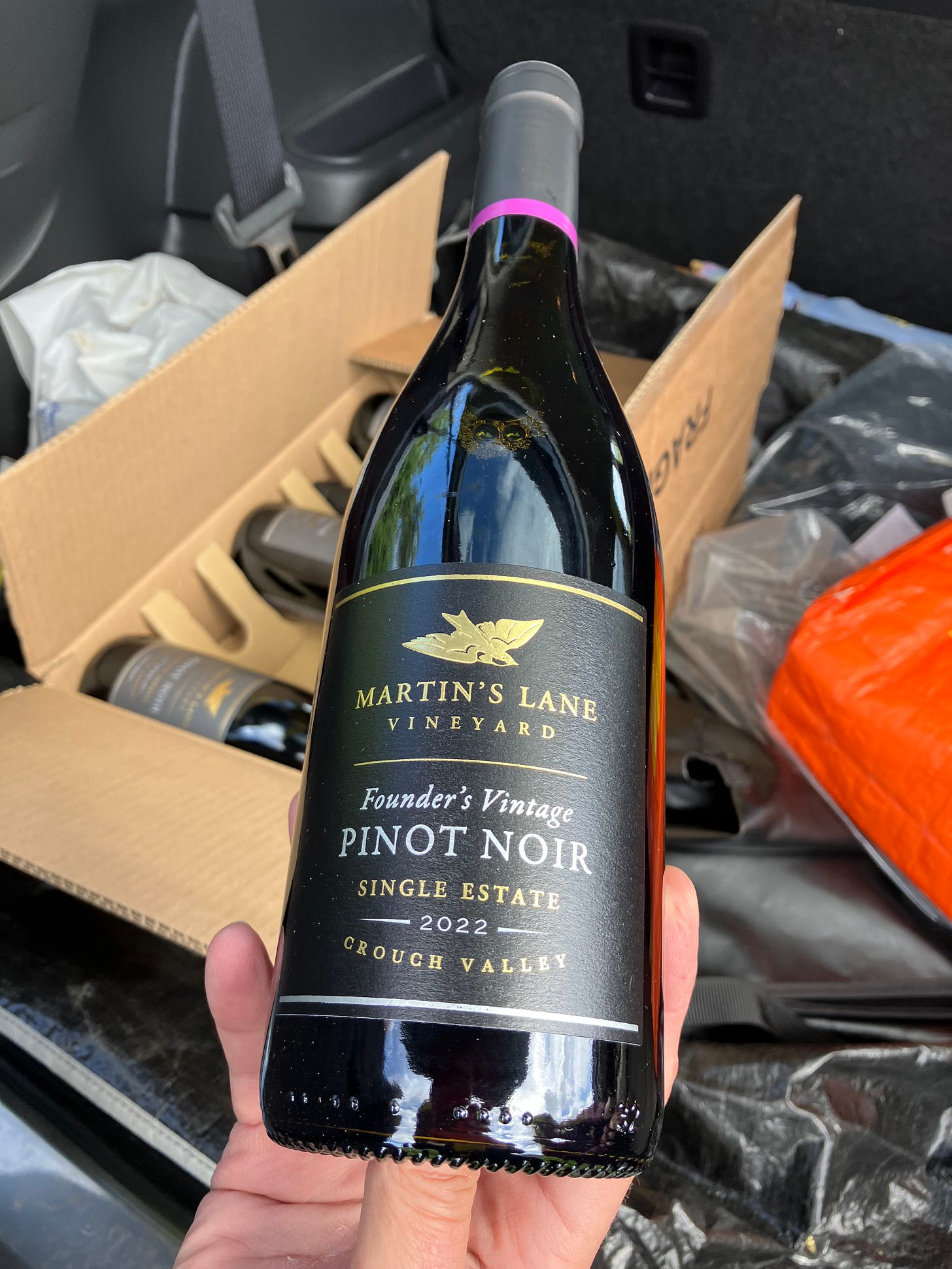The only way is Essex
The eastern county's Crouch Valley is the hottest new region in English wine: I visited to find out why. Plus: what I've been drinking this week




ROWS of Pinot Noir vines march away down the hillside in brilliant sunshine: “It’s like being in France!” laughs Caroline Martin. But her husband Graham points to a bright ribbon of water to our south: “That’s the River Crouch.” For this is Essex, and Martin’s Lane Vineyard – one of the leaders in English wine’s newest hot spot.
The big story of English wine’s remarkable surge over the past decade has been the rise of high-quality sparkling wines grown across the chalk belt that stretches from Hampshire to Kent. Yet over the past few years, the new trend that has struck me most at tastings is the arrival of serious still English wines. What’s more, these are wines made using not the hybrid grape varieties and Bacchus once beloved of English growers, but Chardonnay and Pinot Noir. And some of the best are now being made in Essex.
“Essex was the English wine industry’s dirty little secret for years,” says Henry Jeffreys, author of last year’s much-praised Vines in a Cold Climate: The People Behind the English Wine Revolution. “The soil is London clay, so it wasn’t part of the ‘chalk rush’.” And the county’s frankly trashy image in national life doesn’t exactly fit with the serious wine production. Yet for 15 years, Essex has been known as a source of quality grapes for a number of producers based elsewhere, most notably Lyme Bay in east Devon.
The reason: this is one of the warmest and driest parts of the country. But the Crouch Valley is particularly special, a sheltered spot in between the Blackwater estuary to the north and the sea to the south, just south east of Chelmsford. Graham Martin tells me the last late frost here was 13 years ago – a better record than Burgundy, which suffered April frosts in 2021, 2022 and again this year.
The area’s first producer was New Hall Vineyards, founded as long ago as 1969. But even ten years ago there were still only four vineyards here; now there are around 25. The big difference between these operations and those of the chalk belt is that most Essex vineyards only grow grapes. There are still only three wineries, the newest and most ambitious of which is Danbury Ridge, first planted in 2014.
“It’s a farming mentality,” says Danbury Ridge’s winemaker, Liam Idzikowski, ex-Lyme Bay. “[The growers] can see they can grow grapes as a cash crop, but don’t have the know-how to make and market the wine.” Graham Martin is more succinct: “You can break your back growing wheat or peas for £250 a tonne or you can do this.”
But while top growers like Martin do now sell some of the own wine, made for them under contract, Janine Bunker of Danbury Ridge warns that “If you’re going to be consistently producing quality Pinot Noir, you need control in the winery as well as vineyard.” For Danbury, that means hard decisions over yields to maintain quality. Most English growers celebrated last year’s record-breaking harvest, but at Danbury Ridge they were green-harvesting grapes to limit them to six bunches per vine: “for us, big yields are not a celebration,” she says.
One English winemaker impressed by Danbury Ridge is Charlie Holland, previously at leading Kent producer Gusbourne. He made some decent still Pinot Noir and Chardonnay at Gusbourne, alongside the estate’s mostly sparkling production, although they didn’t manage it every year and volumes were small.
“Then I tasted the first Danbury vintage [2018] and I just thought, ‘wow, this is another level up,’” says Holland.
Still, 2018 was a relatively easy English vintage to make good wine; one key thing about the Crouch Valley, for Holland, is the consistency across years. “It was the 2021 that really stood out for me,” he recalls. “Most of the country couldn’t even get grapes to 11 per cent alcohol but Danbury and Martin’s Lane were at 13 per cent.
“I had confidence we could do it - but every year?” says Idzikowski. “But so far we’ve been able to make wine every year that I’m proud of.” Danbury Ridge’s 2021 Chardonnay and Pinot Noir are indeed serious wines. The Chardonnay balances acidity with ripe fruit and well-integrated oak, long and elegant; the Pinot Noir is a very Burgundian expression of berry fruit and elegant tannins.
This kind of potential is why Holland now heads up a major English expansion by California’s Jackson Family Wines. Last year Jackson bought 67 acres (27 ha) here in spot looking over the Crouch. Half were planted just a few weeks ago with Chardonnay and Pinot Noir (Burgundian clones); the rest will be planted next year. While the new vines won’t be fully productive until 2028, for the moment Jackson is buying in fruit that will be vinified for them by contract-only winery Defined Wine.
But Holland adds: “I imagine at some point in the future we’ll want to build our own winery.” Earlier this week Jackson joined industry body WineGB.
Jackson’s entrance is part of its global investment in cool-climate wines to be sustainable for the future: it is also planting on Vancouver Island in Canada. Meanwhile several Burgundian producers have visited the Crouch Valley and are rumoured to be weighing up land purchases. Can Essex really offer that much to international players?
“Part of the appeal of the Crouch Valley is that it’s geographically quite small,” says Holland. “If you’re going to create a Napa of England, the limited size is attractive.”
He is also a long-standing champion of clay soils, like those of the original plantings at Gusbourne: “drainage is always an issue with clay but if you can manage that, the vines are usually further ahead and it gives the wines lovely body and texture.” Key to the Crouch Valley’s clay is its high proportion of the mineral smectite, which allows the clay to expand and contract with water, thereby giving a degree of drought protection.
Lucy Winward of Crouch Valley pioneers New Hall Vineyards isn’t surprised by the interest from overseas. “I think there is room for large-scale expansion,” she says. “There’s plenty more opportunity to grow, although obviously the microclimate only stretches so far.”
The challenges of making serious still wine in even a warm English climate remain considerable. “People are quick to forgive poor Burgundy - we don’t have that,” warns Janine Bunker. But the Crouch Valley is showing what could be possible.
“If you put all the elements together at the highest standard, what is possible for English still wine?” asks Bunker. “That’s what drives us.”
Danbury Ridge’s wines are available from Berry Brothers, The Wine Society, Four Walls Wine, Hedonism Wines and Brunswick Fine Wines and Spirits, from £33.
What I’ve been drinking this week
Domaine de la Chevalerie “Franco de Porc” 2020, Bourgueil - Bourgueil is usually considered the most serious and ageworthy of Loire reds, and the biodynamic wines of Stéphanie Caslot and her siblings are as fine an example as any. Made from 25 year-old Cabernet Franc vines, this bursts with pure, juicy, red-berry and bitter-cherry fruit, balanced by a brisk acidity. I’m not completely sure of the significance of the French pun in the wine’s name (“franco de port” = “post-paid” for mail-order items) but there are mischievous pigs on the label and it would indeed be a fine match for the fattiness of roast or barbecued pork (Symposium Wine Emporium, The Good Wine Shop, Le Caves de Pyrene and elsewhere, from £16.50; also in Vinoteca wine bars in London, £40.)
Selenita Nit 2018, Montsant - a classic combination from this Catalan denominación of old-vine Garnacha and Samsó (aka Carignan): a savoury, herbal nose; minerality and herbs on the palate, grippy structure but with some softness from its bottle age, and nice length (was Wine Society, now N/A UK; about £13 in Spain.)
Artisans Vignerons de Naoussa, 'Skyphos' Xinomavro, 2019 - regular readers will know my affection for Xinomavro, Greece’s greatest red grape. It can age well although sadly you rarely see bottles either here or in Greece with more than a few years’ bottle age on them: this one gives a hint of how it can evolve. Earthy, savoury fruit with grip, elegance and length - lovely (The Sourcing Table, £19.90.)
Transparency declaration: I visited Danbury Ridge and Martin’s Lane Vineyard as a guest of the owners.




